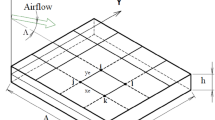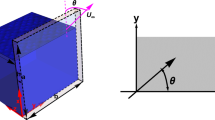Abstract
The aim of this paper is to present a new aeroelastic stability model taking into account the viscous effects for a supersonic nozzle flow in overexpanded regimes. This model is inspired by the Pekkari model which was developed initially for perfect fluid flow. The new model called the “Modified Pekkari Model” (MPM) considers a more realistic wall pressure profile for the case of a free shock separation inside the supersonic nozzle using the free interaction theory of Chapman. To reach this objective, a code for structure computation coupled with aerodynamic excitation effects is developed that allows the analysis of aeroelastic stability for the overexpanded nozzles. The main results are presented in a comparative manner using existing models (Pekkari model and its extended version) and the modified Pekkari model developed in this work.










Similar content being viewed by others
Abbreviations
- A :
-
Aerodynamic influence coefficient
- \(C_{\mathrm{f}}\) :
-
Friction coefficient
- \(F_\mathrm{k}\) :
-
Universal function of Chapman for the interaction zone
- \(\vec {f}_\mathrm{a} \) :
-
Aerodynamic loads
- {F} :
-
Force vector
- jp :
-
Number of elementary elements in the free interaction region
- [K], [\(K_{\mathrm{aero}}\)]:
-
Stiffness and aerodynamic rigidity matrices
- L :
-
Interaction length
- l :
-
Element length in the interaction region
- [M]:
-
Mass matrix
- M :
-
Mach number
- \(N_{i}\) :
-
Shape function
- \(\vec {n}\) :
-
Normal unit vector
- P :
-
Pressure
- \(R^{k}\) :
-
Dynamic influence coefficient
- s :
-
Curvilinear coordinate
- U :
-
Flow velocity
- t :
-
Time
- \(w_\mathrm{n} \) :
-
Normal displacement
- \(\{ V \}, \{ {\overline{{V}}}\}\) :
-
Natural and aeroelastic eigenmode vectors, respectively
- \(\{ W \}, \{ {\ddot{W}} \}\) :
-
Nodal displacement and acceleration vectors, respectively
- \(X_{i}\) :
-
coordinate along the axis of the nozzle
- \(X^{k}_{\mathrm{n}}\) :
-
Normal displacement of the mode k
- \(\gamma \) :
-
Specific heat ratio
- \(\sigma \) :
-
Heaviside function
- \(\rho \) :
-
Density of the fluid
- \(\omega ^k \) :
-
Structure natural frequency for mode k
- \(\Omega ^k \) :
-
Aeroelastic frequency for mode k
- \(\eta ^{x}, \eta ^{y}\) :
-
Normal unit vector components
- atm:
-
Ambient condition
- c:
-
Chamber condition
- k:
-
Relative to the interaction zone
- n:
-
Normal direction to the wall
- p:
-
Plateau
- sep:
-
Separation point
- w:
-
Wall
- \(\infty \) :
-
Isentropic flow condition at a given section of the nozzle
- 0:
-
Equilibrium state
- k :
-
Relative to mode k
- x, y :
-
Cartesian coordinates
- NPR:
-
Nozzle pressure ratio
- MPM:
-
Modified Pekkari model
- PVW:
-
Principle of virtual works
- TSP:
-
Theory of small perturbations
References
Moreaux, N., Girard, S.: Experimental assessment of aeroelastic coupling in a rocket engine nozzle. IFASD (2003)
Moreaux, N.: Essais sur la tuyère souple ATAC au LEA de Poitiers. Technical Report RT 77/00144 DAFE/DDSS, ONERA (2002)
Östlund, J.: Flow processes in rocket engine nozzles with focus on flow separation and side-loads. Technical Report 09, Royal Institute of Technology, Sweden (2002)
Tuovila, W.J., Land, N.S.: Experimental study of aeroelastic instability of over-expanded rocket nozzle extensions. NASA TN D-4471 (1968)
Bekka, N.: Problématique des ondes de choc dans les tuyères supersoniques et leur interaction avec la structure. PhD Thesis, Université d’Evry Val d’Essonne (2014)
Blades, E.L., Baker, M., Pray, C.L., Luke, E.A. :Fluid–structure interaction simulations of rocket engine side loads. SIMULIA Customer Conference (2012)
Garelli, L., Paz, R.R., Storti, M.A.: Fluid–Structure interaction study of the start-up of rocket engine nozzle. Comput. Fluids 39, 1208–1218 (2010). doi:10.1016/j.compfluid.2010.03.005
Lefrançois, E.: A numerical investigation of side-loads resulting from rigid body motions of an over-expanded engine nozzle. Int. J. Numer. Methods Fluids 66(6), 671–689 (2011). doi:10.1002/fld.2268
Lefrançois, E.: Modèle numérique de couplage fuide-structure pour l’étude des phénomènes aéroélastiques avec applications aux moteurs fusée. PhD Thesis, Université de Rouen (1998)
Lüdeke, H., Calvo, J.B., Filimon, A.: Fluid structure interaction at the ARIANE-5 nozzle section by advanced turbulence models. In: Wesseling, P., Oñate, E., Périaux, J. (eds.) European Conference on Computational Fluid Dynamics, ECCOMAS CFD. TU Delft, The Netherlands (2006)
Mouronval, A.-S.: Etude numérique des phénomènes aéroélastiques en aérodynamique supersonique. Application aux tuyères propulsives. PhD Thesis, INSA de Rouen (2004)
Lefrançois, E.: Etude numérique du décollement de jet et du phénomène de charges latérales au sein des moteurs fusée avec prise en compte de l’aéroélasticité. Rapport de post-doctorat, CORIA/CNES (2000)
Pekkari, L.O.: Aeroelastic analysis of side-loads in supersonic nozzles with separated flow. AIAA Paper 94-3377 (1994)
Pekkari, L.O.: Aeroelastic stability of supersonic nozzles with separated flow. AIAA Paper 93-2588 (1993)
Lefrançois, E.: Numerical validation of a stability model for a flexible over-expanded rocket nozzle. Int. J. Numer. Methods Fluids 49(4), 349–369 (2005). doi:10.1002/fld.1000
Chapman, D.R., Huehn, D.M., Larson, H.K.: Investigation of separated flows in supersonic and subsonic streams with emphasis on the effect of transition. Technical Report NACA TR 1356, NACA (1958)
Lighthill, M.J.: Oscillating airfoils at high Mach number. J. Aeronaut. Sci. 20(6), 402–406 (1953)
Ashley, H., Zartarian, G.: Piston theory—a new aerodynamic tool for the aeroelastician. J. Aeronaut. Sci. 23(12), 1109–1118 (1956)
Dowell, E.H.: Aeroelasticity of Plates and Shells. Noordhoff International Publishing, Groningen (1975)
Michel, R.: Couches limites turbulentes et calcul pratique des couches limites en fluide compressible. T.P. ONERA No. 25 (1963)
Carrière, P., Sirieix, M., Solignac, J. L.: Propriétés de similitude des phénomènes de décollement laminaire ou turbulent en écoulement supersonique non uniforme. Technical Report. ONERA TP 659F, ONERA (1968)
Conflict of interest
The authors certify that no actual or potential conflict of interest including any financial, personal or other relationships with other people or organizations within three (3) years of beginning the work submitted that could inappropriately influence (bias) our work.
Author information
Authors and Affiliations
Corresponding author
Additional information
Communicated by F. Lu.
Rights and permissions
About this article
Cite this article
Bekka, N., Sellam, M. & Chpoun, A. Aeroelastic stability analysis of flexible overexpanded rocket nozzle. Shock Waves 26, 513–527 (2016). https://doi.org/10.1007/s00193-015-0575-2
Received:
Revised:
Accepted:
Published:
Issue Date:
DOI: https://doi.org/10.1007/s00193-015-0575-2




